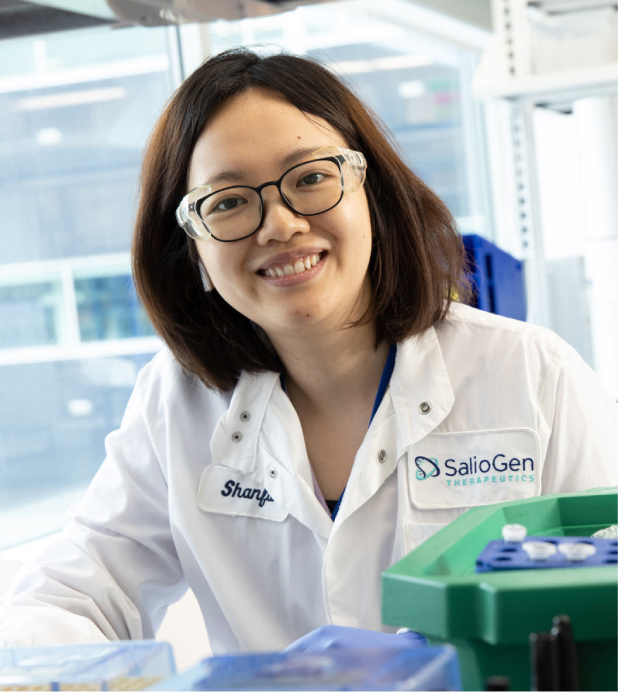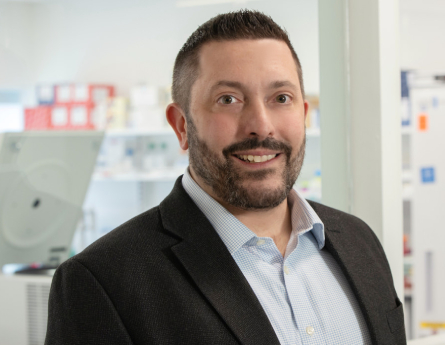Announcements LOREM IPSUM
| Target organ/Cells | indications (Gene of Interest) | Gene size | Est. Prevalence (US + EU) | Discovery | Optimization | IND-Enabling | Clinical |
|---|---|---|---|---|---|---|---|
| Eye/Retina | Stargardt (ABCA4) | 6.8 KB | 60,000 |
|
|||
| Usher Syndrome (USH2A) | 15.6 KB | 16,500 |
|
||||
| Retinitis Pigmentosa 25 (EYS) | 9.5 KB | 4,500 |
|
||||
| LCA10 (CEP290) | 7.4 kB | 3,600 |
|
||||
| Wet AMD (VEGF Trap) * | N/A | 5M+ |
|
||||
| Lung | Cystic Fibrosis (CFTR) | 4.4 kB | 105,000 (WW) |
|
|||
| Ear | Multiple | --- | --- |
|
|||
| Brain/CNS | Multiple | --- | --- |
|
|||
| CAR-T | Oncology*, AutoImmune* | --- | --- |
|
|||
*Programs to be enabled via strategic partnerships
SGT-1001 is SalioGen’s first development candidate using Gene Coding technology. It’s being developed as a one-time, non-viral therapy to slow or stop the progressive loss of central vision in people with Stargardt disease, regardless of the type of mutation. More than 1,000 different mutations in ABCA4, a large (6.8kb) gene, can lead to Stargardt.
SGT-1001 is designed to address the underlying genetic cause of Stargardt. It consists of a full-length ABCA4 gene construct and mRNA coding for Saliogase™ enzyme, SalioGen’s proprietary mammalian-derived bioengineered enzyme. SGT-1001 utilizes a proprietary lipid nanoparticle (LNP) that is delivered subretinally and will be dosed only once.
We look forward to completing IND-enabling studies for SGT-1001 in the second half of 2024 and aim to bring this potential one-time therapy to the clinic in the first half of 2025. The progress we make in Stargardt will help enable us to quickly move forward with other programs for severe, inherited retinal diseases, potentially benefiting a wider range of patients.

We are developing the first permanent cure for CF: a one-time therapy to help patients with any of the ~2,000 mutation types. Using our Gene Coding technology, our potential genetic medicine will integrate a fully functional copy of the CFTR gene into the lung cells to allow healthy CFTR protein to be produced. CFTR is a large gene (4.4kb) and is historically difficult to deliver.
Precise targeting and delivery are required to realize the full potential of Gene Coding for this patient population. We’re making significant progress with our innovative approaches, which will open a wide range of other applications for our technology.
We are open to partnerships that accelerate the potential of our Gene Coding technology.

CEO & Chairman of the Board
Jason is a strategic biotechnology CEO and board member with over 20 years of experience working with public and private biotech companies focused on strategy, capital raising, business development, operations, and enabling teams.
Jason joined SalioGen from bluebird bio, where he served as Chief Strategy and Financial Officer, Chief Business Officer, and Chief Operating and Legal Officer, providing strategic, financial, operational, and legal oversight during key growth and transition periods. In these roles, bluebird bio scaled from 100 to 1,200 employees (U.S. & Europe), secured FDA approval of three first-of-their-kind gene and cell therapies (ZYNTEGLO, SKYSONA, ABECMA), and closed over $3.7 billion in financings and strategy-enabling business development transactions. Before bluebird bio, Jason held positions on the executive leadership teams of Zalicus and CombinatoRx, with responsibility across corporate development, strategic alliances, legal, IT, and facilities.
Jason earned a J.D. from Columbia University and an A.B. in Government from Dartmouth College.

Chief Innovation Officer, Co-Founder & Board Member
Joe is an executive leader, clinician, and scientist dedicated to advancing gene therapies for children and adults with genetic disorders involving the cardiovascular, ophthalmological, neurological, and immunological systems. His background spans pediatrics, child neurology, medical genetics, and molecular developmental neurobiology.
Earlier in his career, Joe worked on the Human Genome Project as the lead of the Human Genetic Initiative. His academic background includes positions as an instructor at Harvard Medical School, an Assistant Professor at George Washington University, an Associate Professor at SUNY Albany, and a Professor at Cornell University. As the Vice President of Clinical Development at uniQure, Joe led Phase 1/2 first-in-human gene therapy trials in Huntington’s disease.
Joe received his medical degree from New York University and graduated cum laude with a B.A. in Biology from Marist College. He is double-board certified in Pediatrics and Neurology with Special Qualification in Child Neurology. He is licensed to practice medicine in New York and Massachusetts.

Senior Vice President, Intellectual Property & Contracts
Jeff has extensive intellectual property (IP) experience, including building and defending IP protection for platform-based technologies and FDA-approved therapeutics.
Previously, Jeff served as Vice President of Intellectual Property at Omega Therapeutics, leading IP and contract activities related to their genomic control technology. Before Omega, Jeff worked at Alnylam Pharmaceuticals for ten years, most recently as Senior Director, Senior Intellectual Property counsel.
Earlier, Jeff was an attorney at Edwards Angell Palmer & Dodge LLP (now Locke Lord LLP) Jeff began his biopharma career at Millennium Pharmaceuticals (now Takeda Pharmaceuticals).
Jeff received his undergraduate degree in microbiology from the University of Massachusetts at Amherst, his graduate degree in molecular microbiology and immunology from Johns Hopkins University, and a law degree from Suffolk University Law School.

Vice President, Portfolio and Program Management
Kate is a biotech leader with 20 years of experience in life sciences and drug development, including extensive work in gene therapy. Her focus is portfolio management, strategic planning, communications, and team leadership.
Prior to SalioGen, Kate served as Vice President, Program Lead and Head of Program Management at Syndax Pharmaceuticals and Freeline Therapeutics. Before that, Kate spent nearly seven years at bluebird bio in roles in Medical Affairs and Program Leadership.
Kate holds a B.A. from Pomona College and an M.A. from the University of Iowa, both in English literature.

Executive Director, Finance & FP&A
Will is a financial leader with over 15 years of experience working in both public and private biotech companies at all stages of development, from discovery through commercialization.
Will most recently was the Senior Director of FP&A for Allena Pharmaceuticals. Before that role, He spent five years as the Senior Director of Finance and Controller for Navitor Pharmaceuticals and nine years at AMAG Pharmaceuticals in various roles, including Controller and Director of FP&A.
Will holds an MBA from Quinnipiac University and a Bachelor of Science in Finance and Accounting from the Darla Moore School of Business at the University of South Carolina.

Vice President, Human Resources
Jill is a senior human resources professional with 20+ years of progressive experience in the biotech industry. Her focus is organizational design, employee development, employee relations, leadership coaching, change management, compensation, benefits administration, and legal compliance.
Jill began her career at ImmunoGen, where she covered all facets of Human Resources and Talent Management during her 14-year tenure. After that, Jill joined Sarepta Therapeutics, where she was responsible for establishing and building the HR Business Partnering function, followed by Rubius Therapeutics where she served as Head of Human Resources.
Jill holds a bachelor’s degree in art and psychology from Carnegie Mellon University and is a certified Executive Coach.

Senior Vice President, Technical Operations
Sandeep has extensive developmental experience in bringing candidates to clinic that span various modalities, including gene therapy, ADCs, mAbs, vaccines, oligonucleotides, bi/tri-specific, and CART.
Before SalioGen, Sandeep worked for 24 years at Pfizer. Recently, his team successfully brought Pfizer’s COVID-19 LNP-mRNA vaccine to the clinic and achieved emergency use authorization. In his last role as Executive Director, Biotherapeutics Pharmaceutical Sciences, Global Biologics, Sandeep was responsible for all pre-proof-of-concept biologics projects, approximately 50 in total, from discovery up to Phase 3 start. Before that, Sandeep established the Protein Pharmaceutical R&D group at Pfizer, which included Formulation, Microbiology, and Stability functions. He is also an adjunct Professor at the University of Tennessee.
Sandeep earned his Ph.D. in Pharmaceuticals from the University of Tennessee Health Science Center and his Bachelor of Pharmacy from Banaras Hindu University. He is also a Certified Regulatory Affairs Professional.

Senior Vice President, Head of R&D
Joe is an R&D leader with experience in nearly all therapeutic modalities, including small molecules, biologics, antisense, gene editing, and mRNA therapeutics. He most recently served as the Vice President of Nonclinical Development at Moderna Therapeutics, where he and his team were responsible for progressing over 40 candidates into the clinic. Before Moderna, Joe served as Site Head for Drug Safety at Takeda Pharmaceuticals, overseeing the development of all immunology products across the portfolio.
Joe earned his Ph.D. in Pharmacology and Physiology from the University of Rochester School of Medicine and Dentistry and his B.S. from Niagara University.